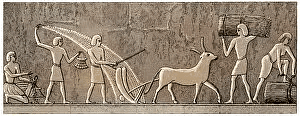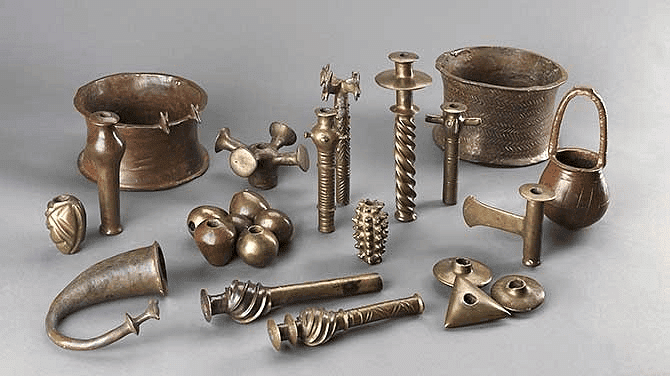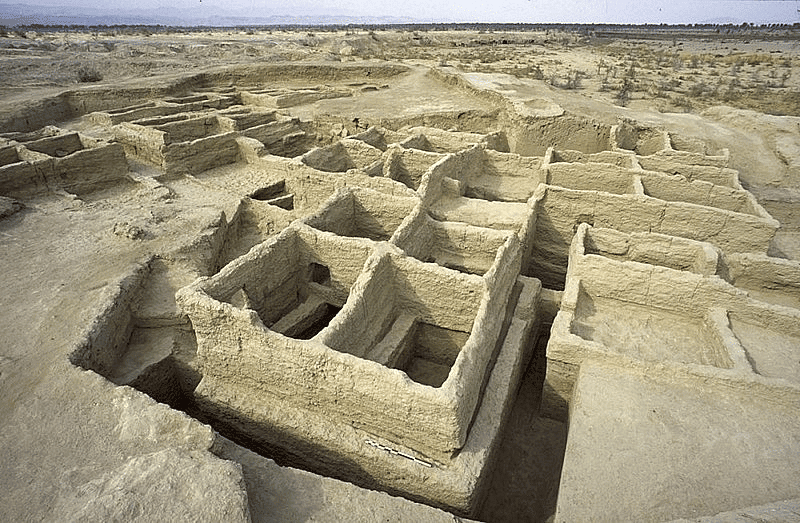CTET & State TET Exam > CTET & State TET Notes > Social Studies & Pedagogy Paper 2 for CTET & TET Exams > Notes: The First Farmers & Herders
Notes: The First Farmers & Herders | Social Studies & Pedagogy Paper 2 for CTET & TET Exams - CTET & State TET PDF Download
A new era in history began with the new stone age. After many years of living a nomadic life, the man started to live a settled life about 10,000 years ago.

The features, tools and significance of the earliest society are discussed below.
Early Society: Features, Tools, and Importance
- In the Narmada valley, remains of hand axes, chopping tools, and bones of Homo erectus have been discovered.
- Bhimbetka has revealed blades, scrapers, and ancient cave paintings.
- This period saw the beginning of techniques for making microliths and crescent-shaped tools, along with the start of settled life.
- There was also the development of polished tools, weaving, cooking, domestication, and pottery making.
The Beginning of Food Produce
- As the world's climate changed, early humans observed various phenomena, including the growth of edible plants in certain areas. They began to notice how seeds naturally fell from plant stalks to the ground, leading to the emergence of new plants.
- In response, these early humans started to nurture these plants, protecting them from birds and animals to ensure their growth and ability to produce seeds.
- Among the first crops to be cultivated were cereals and barley.
- Over time, individuals using tools like sickles transitioned into food producers, marking the beginning of farming.
- This shift to agriculture brought about significant changes in people's lives, encouraging a more settled lifestyle.

Men as Herders
 Domesticated Herding Animals
Domesticated Herding Animals
- People started herding animals and then taming animals by leaving food around their shelters for them.
- Animals such as dogs, pony, pig, goat, donkey, sheep, etc. started to be tamed and domesticated by humans.
- The dog was the first animal to be tamed by humans.
- Animals were an excellent asset for humans as they provided milk, food and even took back burdens. These animals were also shielded from attacks by other wildlife.
First farmers and herders
 Early Farming Artifacts
Early Farming Artifacts
- Archaeologists found evidence of early farmers and herders from the sites of Burzahom, Daojali Hading, Koldihwa, Mehrgarh and many more.
- The remains of burnt grains were recovered from these sites, and the bones of various animals were found.
Tool Finding
- Many stone tools have been found at various sites, and these tools are distinct from Palaeolithic ones, leading to their classification as Neolithic.
- Among the findings are polished weapons with sharp cutting edges, as well as mortars and pestles used for grinding grains and plants.
Human beings as Wheel Inventors
 Wheel and Pottery
Wheel and Pottery
- The invention of the wheel brought about a significant transformation.
- The wheel revolutionized human life by enabling faster travel and facilitating the easier transportation of heavy objects.
Significance of Pottery
- Early humans developed the skill to make handmade, fire-baked clay pottery.
- The introduction of the potter's wheel allowed for the creation of various types of pots, each designed for specific purposes based on their shapes and sizes.
- Additionally, there were different kinds of decorated earthen pots used for storage.
- This innovation marked the beginning of using containers for cooking, particularly for essential grains like rice, wheat, and lentils, which have become staples in the diet.
Question for Notes: The First Farmers & HerdersTry yourself: What was the significance of the invention of the wheel during the new stone age?View Solution
How do we come to know about farmers and herders?
- Archaeological Evidence. Early signs of farmers and herders have been found by archaeologists through various artifacts.
- Evidence from Sites. Pottery, tools, pit houses, paintings, and everyday objects found in sites like Mehrgarh, Burzahom, and North-East India provide evidence of the existence of peasants and herders.

The Chalcolithic Age
- Around 5000 BC, humans began using copper, marking the start of the Chalcolithic Age.
- Tools made of copper were an improvement over those made of stone, leading to this period being called the Copper Age.
- The use of copper tools alongside stone ones represented a significant advancement in technology, shifting from stone to metal tools.
 Mehrgarh (Pakistan)
Mehrgarh (Pakistan)
The Mehrgarh North-West
- Location and Significance: Mehrgarh is recognized as one of the earliest sites of human civilization in the Indian subcontinent, which is now part of Pakistan. Its historical importance lies in the fact that it was here, around 7,000 BC, that humans first domesticated animals.
- Domestication and Agriculture: Mehrgarh is believed to be one of the places where humans first started cultivating barley and wheat, as well as raising sheep and goats. This marks a significant milestone in human history, as it represents the transition from nomadic lifestyles to settled agricultural communities.
- Early Town Life: The site is considered one of the earliest known towns in the world. Archaeological excavations have revealed charred grains and animal bones, providing evidence of the diet and agricultural practices of the people living there.
- Housing and Storage: Remains of rectangular and square houses have been found at Mehrgarh, with each house containing four or more compartments. These compartments were likely used for storage, indicating an early understanding of food preservation and storage techniques.
- Burial Practices: Many burial sites have been uncovered in Mehrgarh, where individuals were buried with goats. This practice is believed to reflect the belief in an afterlife, where the deceased would need sustenance, highlighting the spiritual and cultural beliefs of the people at that time.
The North-East
- Early settlement evidence has been found in Manipur, Tripura, and the Garo Hills.
- Daojali Hading in Assam is a prominent Neolithic site that has unearthed remnants of polished stone tools, ceramics, and cooking implements.
 Pottery from Daojali Hading
Pottery from Daojali Hading
- Jadeite, an important type of jade in trade history, was discovered here and may have been imported from China.
- Tools crafted from fossilized wood and pottery were also found at the site.
The document Notes: The First Farmers & Herders | Social Studies & Pedagogy Paper 2 for CTET & TET Exams - CTET & State TET is a part of the CTET & State TET Course Social Studies & Pedagogy Paper 2 for CTET & TET Exams.
All you need of CTET & State TET at this link: CTET & State TET
|
75 videos|311 docs|77 tests
|
FAQs on Notes: The First Farmers & Herders - Social Studies & Pedagogy Paper 2 for CTET & TET Exams - CTET & State TET
| 1. What were the major crops grown by the first farmers? |  |
Ans. The major crops grown by the first farmers were wheat, barley, peas, lentils, and flax.
| 2. How did the shift to agriculture change the lifestyle of early humans? |  |
Ans. The shift to agriculture allowed early humans to settle in one place, leading to the development of permanent settlements, the growth of population, and the emergence of complex societies.
| 3. What were some of the advantages of domesticating animals for early herders? |  |
Ans. Some advantages of domesticating animals for early herders included a stable food source, production of milk, meat, and wool, and assistance in agricultural activities such as plowing.
| 4. How did the invention of pottery impact early farming communities? |  |
Ans. The invention of pottery allowed early farming communities to store surplus food, water, and other goods, enabling them to settle in larger and more permanent settlements.
| 5. What role did trade play in the development of early farming and herding communities? |  |
Ans. Trade played a crucial role in the development of early farming and herding communities by facilitating the exchange of goods, technologies, and ideas, leading to cultural exchange and the growth of economies.
Related Searches
















